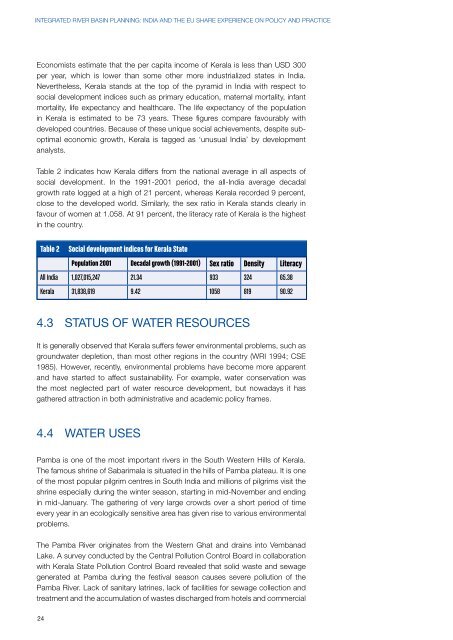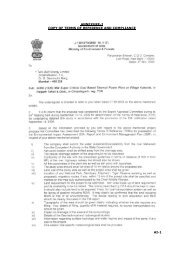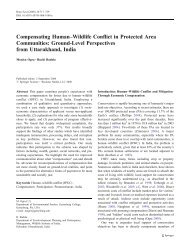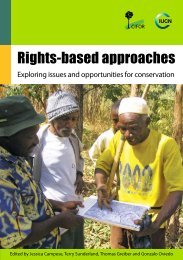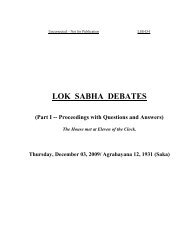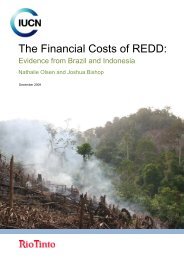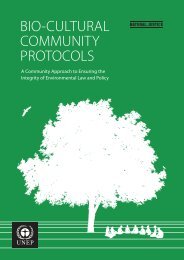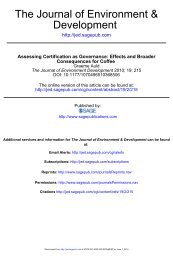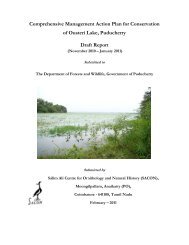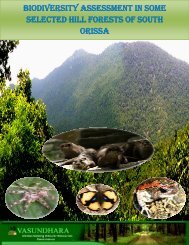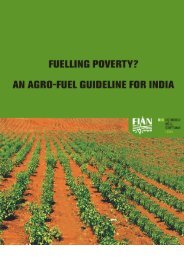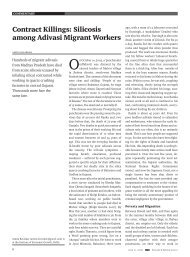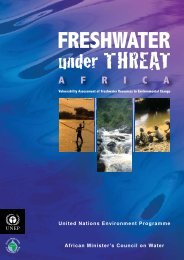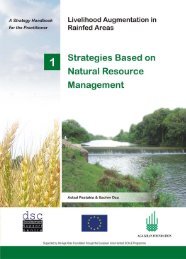Integrated River Basin Planning – Replicable ... - India Water Portal
Integrated River Basin Planning – Replicable ... - India Water Portal
Integrated River Basin Planning – Replicable ... - India Water Portal
You also want an ePaper? Increase the reach of your titles
YUMPU automatically turns print PDFs into web optimized ePapers that Google loves.
<strong>Integrated</strong> <strong>River</strong> <strong>Basin</strong> <strong>Planning</strong>: <strong>India</strong> and the EU share experience on policy and practice<br />
<strong>Water</strong> and Environmental Policies in <strong>India</strong><br />
Economists estimate that the per capita income of Kerala is less than USD 300<br />
per year, which is lower than some other more industrialized states in <strong>India</strong>.<br />
Nevertheless, Kerala stands at the top of the pyramid in <strong>India</strong> with respect to<br />
social development indices such as primary education, maternal mortality, infant<br />
mortality, life expectancy and healthcare. The life expectancy of the population<br />
in Kerala is estimated to be 73 years. These figures compare favourably with<br />
developed countries. Because of these unique social achievements, despite suboptimal<br />
economic growth, Kerala is tagged as ‘unusual <strong>India</strong>’ by development<br />
analysts.<br />
Table 2 indicates how Kerala differs from the national average in all aspects of<br />
social development. In the 1991-2001 period, the all-<strong>India</strong> average decadal<br />
growth rate logged at a high of 21 percent, whereas Kerala recorded 9 percent,<br />
close to the developed world. Similarly, the sex ratio in Kerala stands clearly in<br />
favour of women at 1.058. At 91 percent, the literacy rate of Kerala is the highest<br />
in the country.<br />
Table 2 Social development indices for Kerala State<br />
Population 2001 Decadal growth (1991-2001) Sex ratio Density Literacy<br />
All <strong>India</strong> 1,027,015,247 21.34 933 324 65.38<br />
Kerala 31,838,619 9.42 1058 819 90.92<br />
4.3 Status of water resources<br />
It is generally observed that Kerala suffers fewer environmental problems, such as<br />
groundwater depletion, than most other regions in the country (WRI 1994; CSE<br />
1985). However, recently, environmental problems have become more apparent<br />
and have started to affect sustainability. For example, water conservation was<br />
the most neglected part of water resource development, but nowadays it has<br />
gathered attraction in both administrative and academic policy frames.<br />
4.4 <strong>Water</strong> uses<br />
Pamba is one of the most important rivers in the South Western Hills of Kerala.<br />
The famous shrine of Sabarimala is situated in the hills of Pamba plateau. It is one<br />
of the most popular pilgrim centres in South <strong>India</strong> and millions of pilgrims visit the<br />
shrine especially during the winter season, starting in mid-November and ending<br />
in mid-January. The gathering of very large crowds over a short period of time<br />
every year in an ecologically sensitive area has given rise to various environmental<br />
problems.<br />
The Pamba <strong>River</strong> originates from the Western Ghat and drains into Vembanad<br />
Lake. A survey conducted by the Central Pollution Control Board in collaboration<br />
with Kerala State Pollution Control Board revealed that solid waste and sewage<br />
generated at Pamba during the festival season causes severe pollution of the<br />
Pamba <strong>River</strong>. Lack of sanitary latrines, lack of facilities for sewage collection and<br />
treatment and the accumulation of wastes discharged from hotels and commercial<br />
Sabarimala base camp, December 2009<br />
establishments located at Sabarimala are the major sources for the pollution<br />
of Pamba <strong>River</strong>. To overcome this, the construction of a series of check dams<br />
upstream on the two branches of the river has been taken up. The purpose is to<br />
store sufficient water and release it during the summer months, especially during<br />
the Sabarimala festival, and provide more sanitary and water supply facilities to<br />
the pilgrims during the festival season (CPCB, Annual Report 2000).<br />
Various studies have recorded considerable changes in the land use, especially<br />
around Sabarimala shrine, during the past two decades. Considerable degradation<br />
has also been observed around the Pamba and Kakki reservoirs. The changes<br />
were mainly in the form of conversion and degradation of forests into forest<br />
plantations and other non-forest activities due to human activities. Remarkable<br />
differences were also noted in three major zones mainly based on the level of<br />
human intervention. In the first zone, major changes are from forest-to-forest<br />
plantations whereas in Zone II considerable amount of degradation has been<br />
noticed. The third zone is more or less unaffected compared to other zones. It<br />
has been recorded in the past two decades that the actual forest area has been<br />
reduced considerably, the percentage of reduction in forest cover being around<br />
10.5 percent. The plantation area has also increased considerably during this<br />
period and rubber plantation shows about 51 percent increase.<br />
Although no formal water use studies are available, a general assessment by<br />
experts in the field indicates that, measured by volume, close to 50 percent<br />
of water is utilized for irrigation and domestic water (including drinking) stands<br />
approximately at 10 to 25 percent. <strong>Water</strong> use for power generation and other use<br />
(commercial) are estimated to be about 30 to 35 percent and 10 to 15 percent<br />
respectively. It is also estimated that water for domestic<br />
purposes and commercial purposes records substantial<br />
increase during the peak pilgrim season (mid-November to<br />
mid-January).<br />
The Pamba <strong>River</strong>, from immediately upstream of Sabarimala<br />
to its lower reaches, is highly polluted, especially during the<br />
festival season. This is due to the huge quantity of waste<br />
generated by millions of pilgrims visiting the area. The<br />
pollution is mainly due to human excreta and biodegradable<br />
waste like used leaves, vegetable wastes, discarded clothes,<br />
food wastes etc. Indiscriminate disposal of used plastic<br />
bottles forms the major portion of the non-biodegradable<br />
waste.<br />
4.5 Domestic water use<br />
The drinking water system in Kerala can be classified into two broad categories:<br />
(1) schemes owned and operated by the state government and (2) familymanaged<br />
drinking water supply, which includes individual families creating their<br />
own drinking water resources by constructing wells on their house compounds<br />
and managing the water supply source by themselves. The family-managed<br />
drinking water supply system in Kerala has a substantial role in the water supply<br />
scenario, especially in rural areas.<br />
24 25


